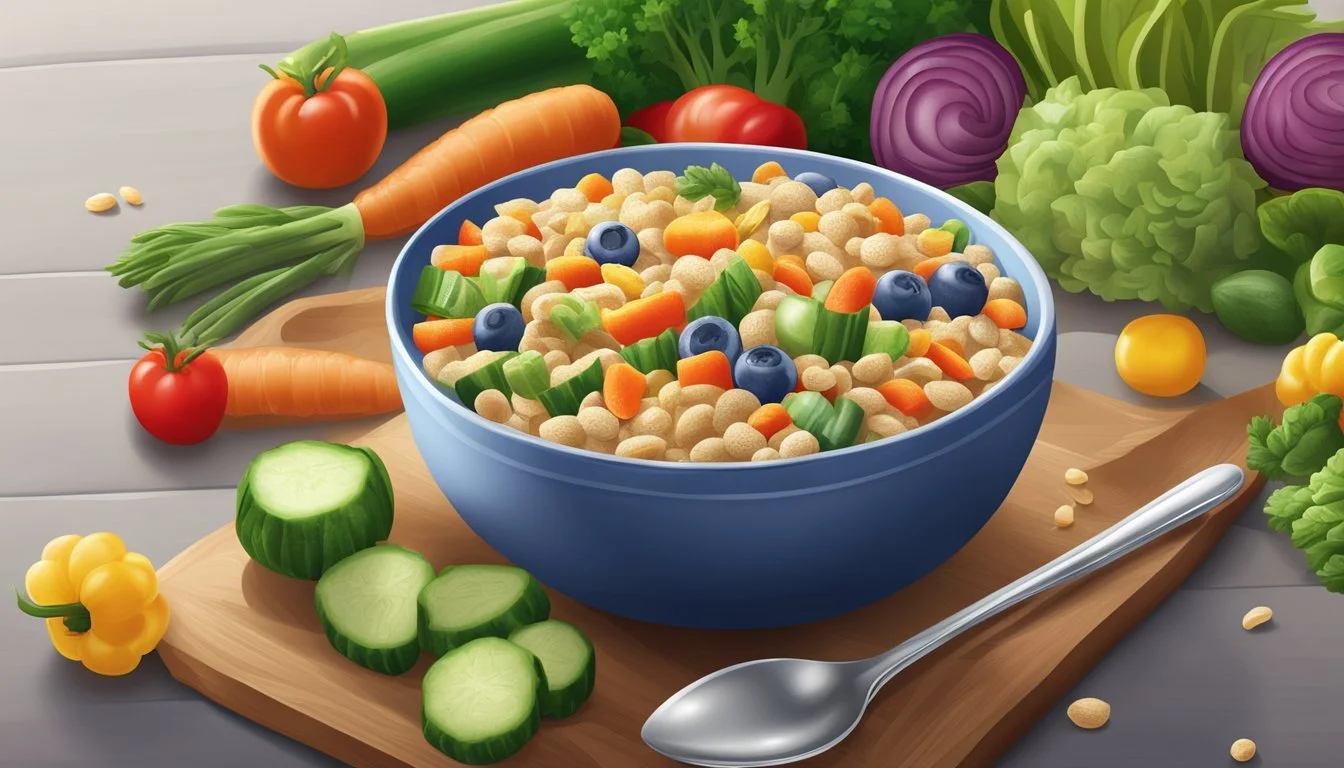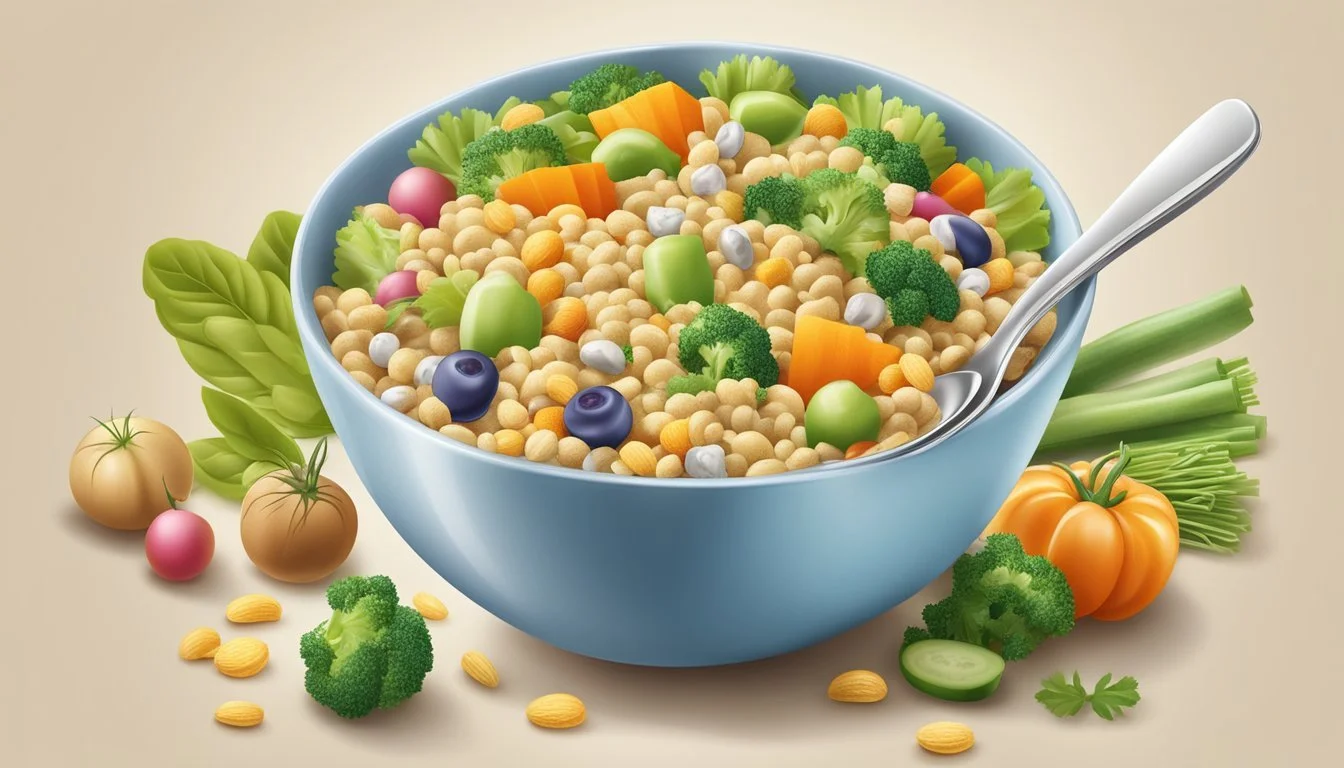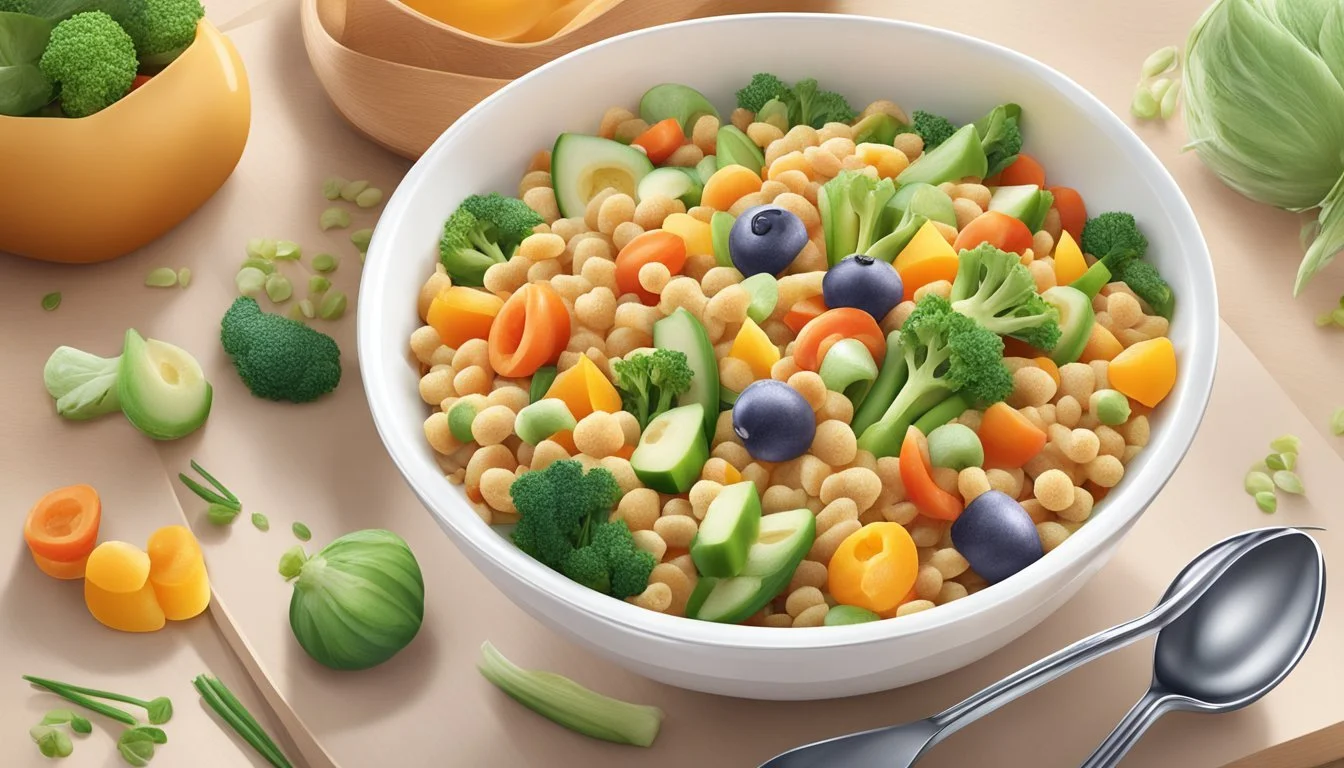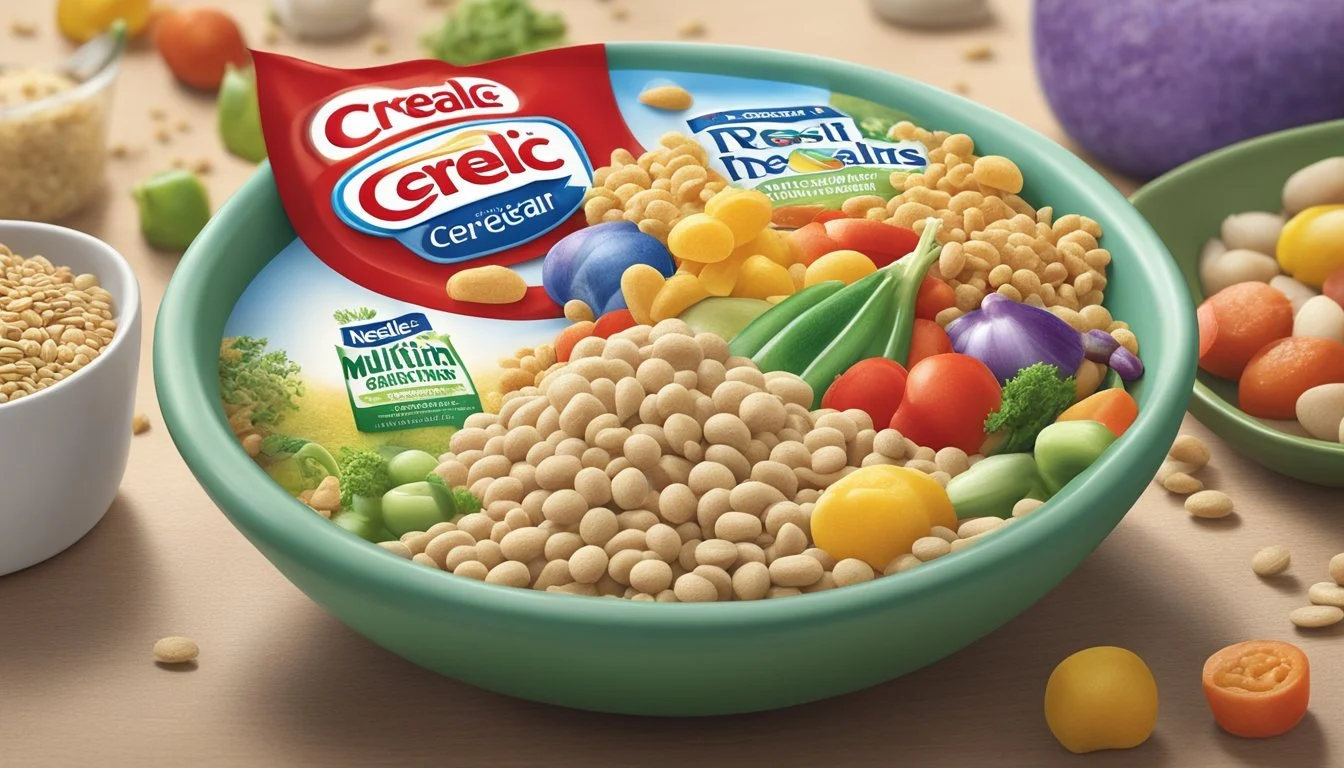Nestlé CERELAC Multigrain & Garden Vegetables
A Balanced Meal for Growing Infants
Nestlé Cerelac Multigrain & Garden Vegetables Cereal offers a nutritious option for infants transitioning to solid foods. This complementary food combines multiple grains with garden vegetables to provide essential nutrients for growing babies. One serving of Cerelac (25g) contains approximately 105 calories, with a balanced mix of carbohydrates, proteins, and fats.
Designed for babies aged 12 to 24 months, Cerelac serves as a source of important vitamins and minerals. It contains iron, which is crucial for infant development, and provides 37% of a baby's daily protein needs in just two servings. The cereal is fortified with 14 key nutrients to support overall growth and health.
Cerelac's convenient preparation makes it a popular choice among parents. The cereal already includes milk powder, requiring only the addition of water to create a smooth consistency suitable for young eaters. This ease of use, combined with its nutritional profile, positions Cerelac as a practical option for introducing infants to a variety of flavors and textures.
Nutritional Profile
Nestle Cerelac Multigrain & Garden Vegetables Cereal provides a blend of essential nutrients for infant growth and development. This fortified cereal combines whole grains with vegetable ingredients to offer a balanced nutritional profile.
Vitamins and Minerals Content
Cerelac is fortified with important vitamins and minerals to support infant health. It contains iron, crucial for cognitive development and preventing anemia. Calcium is added to promote strong bones and teeth. B vitamins like thiamin, riboflavin, and niacin aid in energy metabolism.
The cereal provides vitamin A for eye health and immune function. Vitamin C enhances iron absorption and supports the immune system. Zinc is included to assist growth and immune function.
Iodine, essential for thyroid function and brain development, is also present. The mineral content helps meet infants' increased nutrient needs during rapid growth phases.
Macronutrients Distribution
Cerelac offers a balanced mix of carbohydrates, proteins, and fats. Carbohydrates, primarily from whole grains, provide energy for active babies. Proteins support tissue growth and repair.
The fat content includes essential fatty acids necessary for brain development. A typical serving contains:
Calories: 100-110 per 25g serving
Protein: 3-4g
Fat: 2-3g
Carbohydrates: 18-20g
This distribution aims to meet infants' energy needs while supporting proper growth. The protein content helps build and maintain body tissues.
Importance of Whole Grains
Whole grains form the base of Cerelac Multigrain & Garden Vegetables, offering numerous benefits. These grains provide complex carbohydrates for sustained energy release. They're rich in fiber, aiding digestion and promoting healthy gut bacteria.
Whole grains contribute essential nutrients like B vitamins, vitamin E, and minerals. They offer antioxidants that support overall health. The diverse grain mix may include wheat, rice, and oats, providing a range of nutrients and textures.
This variety helps introduce different tastes and textures to infants, potentially reducing picky eating habits later. Whole grains also help maintain stable blood sugar levels, important for growing babies.
Analyzing Sugars and Sodium
Cerelac's sugar content is carefully balanced to provide energy without excess. Natural sugars from grains and vegetables contribute to the overall carbohydrate content. Added sugars, if present, are typically kept to a minimum to avoid developing a preference for overly sweet foods.
Sodium levels are generally low, as infants have lower sodium requirements than adults. Excessive sodium can strain developing kidneys and potentially impact blood pressure later in life.
The product aims to keep both sugar and sodium within recommended limits for infant nutrition. Parents should check the nutrition label for exact amounts, as formulations may vary slightly between markets or product versions.
Health and Development Benefits
Nestle Cerelac Multigrain & Garden Vegetables cereal offers key nutrients to support infant growth and development. This fortified cereal provides essential vitamins and minerals tailored for babies starting solid foods.
Supporting Infant Growth
The cereal contains iron, which is crucial for healthy growth and development in infants. Iron supports the formation of red blood cells and helps prevent anemia. Calcium and vitamin D are included to promote strong bone development.
Protein in the cereal aids muscle growth and tissue repair. The multigrain blend provides complex carbohydrates for sustained energy. This balanced nutrient profile helps babies meet their increased nutritional needs during rapid growth phases.
Cognitive and Physical Development
Key nutrients in Cerelac support brain and nervous system development. Iron is essential for cognitive function and learning abilities. Omega-3 fatty acids contribute to brain and eye development.
The cereal contains zinc, which plays a role in immune function and growth. B vitamins support energy metabolism and neurological development. The vegetable content provides additional vitamins and minerals that contribute to overall health.
Allergen Information
Cerelac Multigrain & Garden Vegetables contains wheat flour and milk. These are common allergens that parents should be aware of when introducing the cereal.
It's important to introduce new foods gradually and watch for any signs of allergic reactions. Consult a pediatrician before starting Cerelac, especially if there's a family history of food allergies.
The cereal is formulated to be easily digestible for most infants. However, individual tolerances may vary. Start with small amounts and increase gradually as recommended by healthcare professionals.
Cerelac as a Complementary Food
Nestlé Cerelac serves as a nutritious complementary food for infants transitioning to solid foods. It provides essential nutrients to support growth and development when introduced alongside breastmilk or formula.
Introducing to Solids
Cerelac is designed for babies starting at 6 months of age, when they are typically ready to begin exploring solid foods. The smooth texture and easy-to-digest formula make it an ideal first food choice.
Cerelac contains baby-grade ingredients sourced from selected farmers to ensure quality and safety. Parents can start with small amounts, gradually increasing portion sizes as the baby adapts.
To prepare, mix Cerelac powder with water or breastmilk until it reaches the desired consistency. Always follow the package instructions for proper preparation.
Balancing with Breastmilk or Formula
While introducing Cerelac, it's crucial to maintain breastfeeding or formula feeding as the primary source of nutrition. Cerelac complements milk feedings by providing additional nutrients.
Start by offering small tastes of Cerelac after milk feedings. As the baby grows, Cerelac can be incorporated into the daily feeding routine, but should not replace milk entirely.
Cerelac contains iron, vitamins, and minerals to support a balanced weaning diet. However, parents should consult with healthcare professionals for personalized advice on introducing solids and balancing complementary foods with milk feedings.
Taste and Texture Experience
Nestle Cerelac Multigrain & Garden Vegetables offers a unique sensory experience for infants, combining flavors and textures to support healthy eating habits. The cereal's composition aims to introduce babies to various tastes while providing appropriate consistency for their developmental stage.
The Role of Texture in Infant Feeding
Texture plays a crucial role in an infant's feeding journey. Cerelac Multigrain & Garden Vegetables provides a smooth, easily digestible consistency suitable for babies starting solid foods. This texture helps develop oral motor skills and familiarizes infants with different food consistencies.
The cereal's texture can be adjusted by adding more or less liquid, allowing parents to tailor it to their baby's preferences and developmental needs. As babies grow, introducing slightly thicker textures encourages chewing motions and prepares them for more complex foods.
Cultivating a Palette for Vegetables
Introducing vegetables early in a child's diet can help establish healthy eating habits. Cerelac Multigrain & Garden Vegetables incorporates a blend of garden vegetable flavors, offering a gentle introduction to these important food groups.
The cereal's taste is designed to be mild and appealing to young palates. By combining vegetables with familiar grains, it helps infants accept new flavors more readily. This gradual exposure can potentially reduce food aversions and encourage a diverse diet as the child grows.
Parents can mix the cereal with breastmilk or formula to create a familiar taste, easing the transition to solid foods. As babies become more accustomed to the flavors, the cereal can be prepared with water to highlight the vegetable tastes.
Preparation and Serving Suggestions
To prepare Nestlé Cerelac Multigrain & Garden Vegetables cereal, start with clean hands and utensils. Boil drinking water for 5 minutes and allow it to cool to lukewarm temperature.
Pour 60mL of the lukewarm water into a clean bowl. Add approximately 15g (1.5 tablespoons) of the cereal powder. Stir thoroughly to create a smooth consistency without lumps.
For infants, adjust the texture by adding more or less water as needed. A thinner consistency is suitable for younger babies, while older infants may prefer a thicker texture.
Serve the prepared cereal immediately. Use a clean spoon to feed the infant, ensuring the bowl is at a comfortable temperature.
Store unopened packages in a cool, dry place. Once opened, reseal the package tightly and use within 3-4 weeks for optimal freshness and nutritional value.
Cerelac can be incorporated into various meals throughout the day. It pairs well with pureed fruits or vegetables for added flavor and nutrition.
For older infants, try mixing Cerelac with yogurt or using it to thicken soups and broths. This versatility allows for diverse meal options as the child's palate develops.
Always consult with a pediatrician regarding the appropriate serving size and frequency for your infant's specific needs and stage of development.
Comparison with Other Cerelac Varieties
Nestlé Cerelac offers a range of infant cereal options with varying ingredients and nutritional profiles. The multigrain and garden vegetables variety differs from other Cerelac products in terms of nutrient content, taste, and texture.
Cerelac Rice and Wheat Variants
Cerelac Rice is a single-grain option suitable for early weaning. It has a smoother texture compared to the multigrain variety. Rice variants are often fortified with iron and other essential nutrients but may have a lower fiber content.
Wheat-based Cerelac provides more protein and fiber than rice versions. It has a slightly thicker consistency and a mild, nutty flavor. The multigrain and garden vegetables variant combines the benefits of both rice and wheat, offering a more diverse nutrient profile.
Cerelac and Fruit Mixes
Fruit-based Cerelac varieties, such as banana and apple, introduce babies to new flavors. These options typically contain added sugars from fruit purees, making them sweeter than vegetable-based cereals.
The multigrain and garden vegetables Cerelac has a more savory taste profile. It provides a broader range of nutrients from various grains and vegetables. This variety may be preferable for parents looking to limit sugar intake while still offering diverse flavors and textures to their infants.
Availability and Options
Nestlé Cerelac Multigrain & Garden Vegetables cereal is widely distributed across various markets. The product comes in different package sizes to suit diverse consumer needs.
Global Availability
Nestlé Cerelac Multigrain & Garden Vegetables cereal is available in numerous countries worldwide. It has a strong presence in India, Africa, and the Philippines. The product can also be found in select European nations like Belgium and Portugal.
In some regions, it may be sold under slightly different names or formulations to meet local regulations and preferences. Online retailers often stock this variant, making it accessible to consumers in countries where it's not commonly found in physical stores.
Packaging Sizes and Types
The cereal is typically offered in various packaging sizes to cater to different household needs:
250g pouches
300g boxes
400g tins
Larger sizes may be available in some markets for added value. The packaging is designed for easy storage and to maintain product freshness. Resealable options are common to ensure convenience and preserve nutritional quality after opening.
Some regions may offer single-serve sachets, ideal for travel or trial purposes. Special gift packs or multipacks might be available during promotional periods or in certain retail channels.







